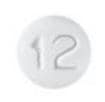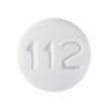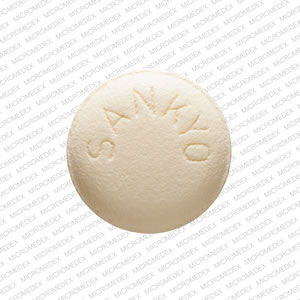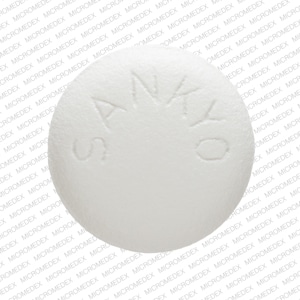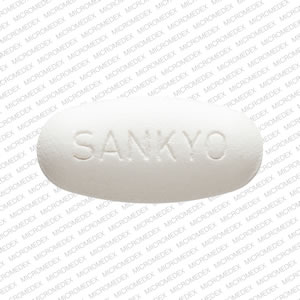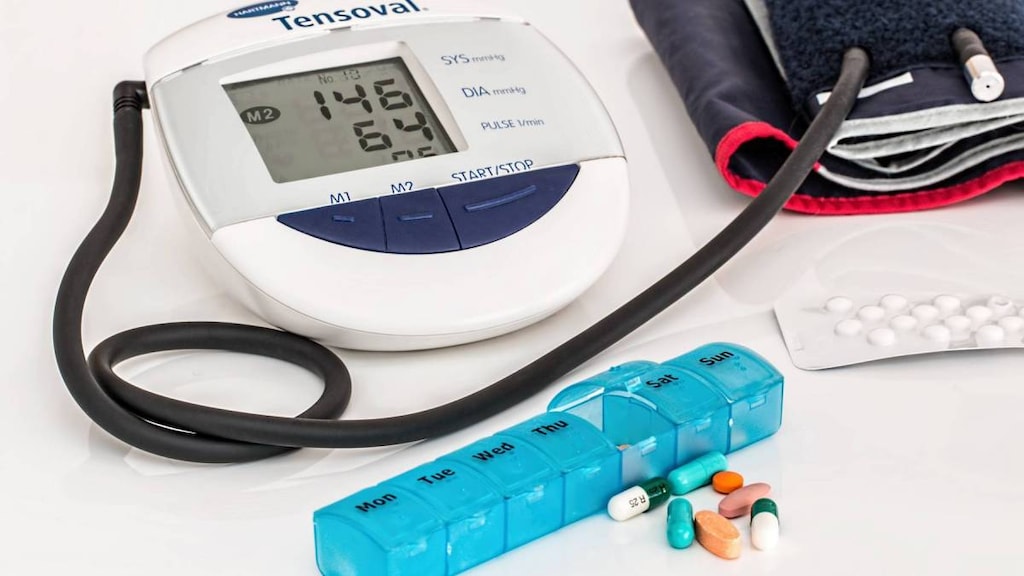Boxed Warning
Fetal toxicity:
When pregnancy is detected, discontinue olmesartan as soon as possible. Drugs that act directly on the renin-angiotensin system can cause injury and even death to the developing fetus.
Dosage Forms
Excipient information presented when available (limited, particularly for generics); consult specific product labeling.
Tablet, Oral, as medoxomil:
Benicar: 5 mg, 20 mg, 40 mg
Generic: 5 mg, 20 mg, 40 mg
Pharmacology
Mechanism of Action
As a selective and competitive, nonpeptide angiotensin II receptor antagonist, olmesartan blocks the vasoconstrictor and aldosterone-secreting effects of angiotensin II; olmesartan interacts reversibly at the AT1 and AT2 receptors of many tissues and has slow dissociation kinetics; its affinity for the AT1 receptor is 12,500 times greater than the AT2 receptor. Angiotensin II receptor antagonists may induce a more complete inhibition of the renin-angiotensin system than ACE inhibitors, they do not affect the response to bradykinin, and are less likely to be associated with non-renin-angiotensin effects (eg, cough and angioedema). Olmesartan increases urinary flow rate and, in addition to being natriuretic and kaliuretic, increases excretion of chloride, magnesium, uric acid, calcium, and phosphate.
Pharmacokinetics/Pharmacodynamics
Distribution
17 L; does not cross the blood-brain barrier (animal studies)
Metabolism
Olmesartan medoxomil is hydrolyzed in the GI tract to active olmesartan. No further metabolism occurs.
Excretion
All as unchanged drug: Feces (50% to 65%); urine (35% to 50%); Clearance: 1.3 L/hour; similar data reported in children (1 to 16 years) when adjusted by body weight
Time to Peak
1 to 2 hours
Half-Life Elimination
Terminal: 13 hours
Protein Binding
99%
Use in Specific Populations
Special Populations: Renal Function Impairment
AUC is approximately tripled when CrCl is <20 mL/minute.
Special Populations: Hepatic Function Impairment
In patients with moderate hepatic impairment, AUC increased by ~60%; Cmax was also increased.
Special Populations: Elderly
AUC increased by 33%, and there is a 30% reduction in renal Cl.
Special Populations: Gender
AUC and Cmax increased 10% to 15% in women.
Special Populations: Race
Antihypertensive effect was smaller in black patients.
Use: Labeled Indications
Hypertension: Management of hypertension in adults and pediatric patients ≥6 years of age.
Use: Off Label
Non-ST-elevation acute coronary syndromeyes
Based on the 2014 American Heart Association/American College of Cardiology (AHA/ACC) guidelines for the management of patients with non-ST-elevation acute coronary syndromes, an angiotensin II receptor blocker (ARB) is recommended and effective in patients who have indications for but are intolerant of angiotensin-converting enzyme (ACE) inhibitors; this includes patients with hypertension, diabetes, stable chronic kidney disease (CKD), heart failure, or myocardial infarction who have a left ventricular ejection fraction ≤40%.
Proteinuric chronic kidney disease (diabetic or nondiabetic)yes
Based on the 2012 Kidney Disease Improving Global Outcomes guidelines, the use of an ACE inhibitor or an ARB is recommended in patients with proteinuric CKD to prevent progression of CKD.
ST-elevation myocardial infarctionyes
Based on the 2013 ACC/AHA guidelines for the management of patients with ST-elevation acute coronary syndromes, an ARB is recommended and effective in patients who have indications for but are intolerant of ACE inhibitors.
Contraindications
Concomitant use with aliskiren in patients with diabetes mellitus
Canadian labeling: Additional contraindications (not in US labeling): Hypersensitivity to olmesartan or any component of the formulation; concomitant use with aliskiren in patients with moderate to severe renal impairment (GFR <60 mL/minute/1.73 m2)
Documentation of allergenic cross-reactivity for angiotensin II receptor blockers is limited. However, because of similarities in chemical structure and/or pharmacologic actions, the possibility of cross-sensitivity cannot be ruled out with certainty.
Dosage and Administration
Dosing: Adult
Acute coronary syndromes: Note: May be used as an alternative in patients who cannot tolerate an ACE inhibitor (eg, due to cough) (ACC/AHA [Amsterdam 2014; O'Gara 2013]; Guyer 2019). In patients with prior angiotensin-converting enzyme (ACE) inhibitor-associated angioedema (ie, without urticaria or other signs of hypersensitivity), an angiotensin II receptor blocker (ARB) may also be an alternative. ARBs do not appear to elevate the risk of angioedema (Rasmussen 2019; Toh 2012); however, patients must be educated that angioedema due to an ACE inhibitor can sometimes reoccur within months following discontinuation (Beltrami 2011); referral to an allergist may be appropriate.
Non-ST-elevation acute coronary syndrome (alternative agent) (off-label use): Note: Patients should be hemodynamically stable before initiation. Use as a component of an appropriate medical regimen, which may also include antiplatelet agent(s), a beta-blocker, and a statin. Continue ARB therapy indefinitely for patients with concurrent diabetes, left ventricular ejection fraction ≤40%, hypertension, or stable chronic kidney disease (CKD) (AHA/ACC [Amsterdam 2014]). Dosing is based on general dosing range in the manufacturer's labeling.
Oral: Initial: 20 mg once daily; increase dose as tolerated up to 40 mg/day under close monitoring to avoid hypotension.
ST-elevation myocardial infarction (alternative agent) (off-label use): Note: Patients should be hemodynamically stable before initiation. Use as a component of an appropriate medical regimen, which may also include antiplatelet agent(s), a beta-blocker, and a statin. Continue ARB therapy indefinitely (ACC/AHA [O'Gara 2013]). Dosing is based on general dosing range in the manufacturer's labeling.
Oral: Initial: 20 mg once daily; increase dose as tolerated up to 40 mg/day under close monitoring to avoid hypotension.
Hypertension: Note: For initial treatment in patients with blood pressure ≥20/10 mm Hg above goal, may be used in combination with another appropriate agent (eg, long-acting dihydropyridine calcium channel blocker, thiazide diuretic). For patients <20/10 mm Hg above goal, some experts recommend an initial trial of monotherapy; however, over time, many patients will require combination therapy (ACC/AHA [Whelton 2018]; Mann 2019a).
Oral: Initial: 20 mg once daily; evaluate response every 4 to 6 weeks and increase dose as needed up to 40 mg once daily (ACC/AHA [Whelton 2018]; Mann 2019a).
Proteinuric chronic kidney disease (diabetic or nondiabetic) (off-label use): Note: In nondiabetic and type 2 diabetic proteinuric chronic kidney disease (CKD), an ARB or an ACE inhibitor may be used. In type 1 diabetic proteinuric CKD, an ARB may be used as an alternative in patients who cannot tolerate an ACE inhibitor (eg, due to cough) (Bakris 2019; Mann 2019b; McCulloch 2019). In patients with prior ACE inhibitor-associated angioedema (ie, without urticaria or other signs of hypersensitivity), olmesartan may be an alternative. ARBs do not appear to elevate the risk of angioedema (Rasmussen 2019; Toh 2012); however, patients must be educated that angioedema due to an ACE inhibitor can sometimes reoccur within months following discontinuation (Beltrami 2011); referral to an allergist may be appropriate. Dosing is based on general dosing range in the manufacturer's labeling.
Oral: Initial: 20 mg once daily; can be increased to 40 mg once daily based on blood pressure response and tolerability. Target to an appropriate blood pressure goal and a proteinuria goal of <1 g/day (KDIGO 2013; Mann 2019b).
IgA nephropathy: In addition to an appropriate blood pressure goal, a proteinuria goal of <1 g/day is also generally recommended (KDIGO 2012). Some experts treat to a proteinuria goal of <500 mg/day. If proteinuria goal is not met with monotherapy at the maximum dose, consider adding other modalities and/or agents (Cattran 2019).
Dosing: Geriatric
Refer to adult dosing.
Dosing: Pediatric
Note: Consider lower starting dose in patients with possible depletion of intravascular volume (eg, patients receiving diuretics).
Hypertension: Oral:
Children 1 to 5 years and ≥5 kg: Limited data available; efficacy results variable: Initial: 0.3 mg/kg/dose once daily; if initial response inadequate after 2 weeks, dose may be increased to 0.6 mg/kg/dose once daily. Dosing was evaluated in a double-blind, placebo-controlled study of 59 patients and some efficacy was demonstrated; however, results were not statistically significant.
Children and Adolescents 6 to 16 years:
20 to <35 kg: 10 mg once daily; if initial response inadequate after 2 weeks, dose may be increased; maximum daily dose: 20 mg/day
≥35 kg: 20 mg once daily; if initial response inadequate after 2 weeks, dose may be increased; maximum daily dose: 40 mg/day
Adolescents >16 years: Initial: 20 mg once daily; if initial response is inadequate, may be increased to 40 mg once daily after 2 weeks
Extemporaneously Prepared
A 2 mg/mL oral suspension may be made with olmesartan tablets. Combine 50 mL purified water and twenty 20 mg tablets in an 8-ounce amber bottle and allow to stand for ≥5 minutes. Shake well for ≥1 minute, then allow to stand for ≥1 minute. Repeat shaking and standing process four additional times. Add 100 mL Ora-Sweet® and 50 mL Ora-Plus® to the suspension and shake well for ≥1 minute. Label "shake well" and "refrigerate". Stable for 28 days refrigerated.
Benicar® prescribing information, Daiichi Sankyo, Inc, Parsippany, NJ, 2010.
Administration
Oral: Administer with or without food.
Storage
Store at 20°C to 25°C (68°F to 77°F).
Olmesartan Images
Drug Interactions
Alfuzosin: May enhance the hypotensive effect of Blood Pressure Lowering Agents. Monitor therapy
Aliskiren: May enhance the hyperkalemic effect of Angiotensin II Receptor Blockers. Aliskiren may enhance the hypotensive effect of Angiotensin II Receptor Blockers. Aliskiren may enhance the nephrotoxic effect of Angiotensin II Receptor Blockers. Management: Aliskiren use with ACEIs or ARBs in patients with diabetes is contraindicated. Combined use in other patients should be avoided, particularly when CrCl is less than 60 mL/min. If combined, monitor potassium, creatinine, and blood pressure closely. Consider therapy modification
Amifostine: Blood Pressure Lowering Agents may enhance the hypotensive effect of Amifostine. Management: When amifostine is used at chemotherapy doses, blood pressure lowering medications should be withheld for 24 hours prior to amifostine administration. If blood pressure lowering therapy cannot be withheld, amifostine should not be administered. Consider therapy modification
Amphetamines: May diminish the antihypertensive effect of Antihypertensive Agents. Monitor therapy
Angiotensin II: Receptor Blockers may diminish the therapeutic effect of Angiotensin II. Monitor therapy
Angiotensin-Converting Enzyme Inhibitors: Angiotensin II Receptor Blockers may enhance the adverse/toxic effect of Angiotensin-Converting Enzyme Inhibitors. Angiotensin II Receptor Blockers may increase the serum concentration of Angiotensin-Converting Enzyme Inhibitors. Management: In US labeling, use of telmisartan and ramipril is not recommended. It is not clear if any other combination of an ACE inhibitor and an ARB would be any safer. Consider alternatives to the combination when possible. Consider therapy modification
Antipsychotic Agents (Second Generation [Atypical]): Blood Pressure Lowering Agents may enhance the hypotensive effect of Antipsychotic Agents (Second Generation [Atypical]). Monitor therapy
Barbiturates: May enhance the hypotensive effect of Blood Pressure Lowering Agents. Monitor therapy
Benperidol: May enhance the hypotensive effect of Blood Pressure Lowering Agents. Monitor therapy
Brigatinib: May diminish the antihypertensive effect of Antihypertensive Agents. Brigatinib may enhance the bradycardic effect of Antihypertensive Agents. Monitor therapy
Brimonidine (Topical): May enhance the hypotensive effect of Blood Pressure Lowering Agents. Monitor therapy
Bromperidol: Blood Pressure Lowering Agents may enhance the hypotensive effect of Bromperidol. Bromperidol may diminish the hypotensive effect of Blood Pressure Lowering Agents. Avoid combination
Colesevelam: May decrease the serum concentration of Olmesartan. Management: Administer olmesartan at least 4 hours prior to colesevelam. Consider therapy modification
CycloSPORINE (Systemic): Angiotensin II Receptor Blockers may enhance the hyperkalemic effect of CycloSPORINE (Systemic). Monitor therapy
Dapoxetine: May enhance the orthostatic hypotensive effect of Angiotensin II Receptor Blockers. Monitor therapy
Dexmethylphenidate: May diminish the therapeutic effect of Antihypertensive Agents. Monitor therapy
Diazoxide: May enhance the hypotensive effect of Blood Pressure Lowering Agents. Monitor therapy
Drospirenone: Angiotensin II Receptor Blockers may enhance the hyperkalemic effect of Drospirenone. Monitor therapy
DULoxetine: Blood Pressure Lowering Agents may enhance the hypotensive effect of DULoxetine. Monitor therapy
Eltrombopag: May increase the serum concentration of OATP1B1/1B3 (SLCO1B1/1B3) Substrates. Monitor therapy
Eplerenone: May enhance the hyperkalemic effect of Angiotensin II Receptor Blockers. Monitor therapy
Gemfibrozil: May increase the serum concentration of OATP1B1/1B3 (SLCO1B1/1B3) Substrates. See separate drug interaction monographs for agents listed as exceptions. Monitor therapy
Heparin: May enhance the hyperkalemic effect of Angiotensin II Receptor Blockers. Monitor therapy
Heparins (Low Molecular Weight): May enhance the hyperkalemic effect of Angiotensin II Receptor Blockers. Monitor therapy
Herbs (Hypertensive Properties): May diminish the antihypertensive effect of Antihypertensive Agents. Monitor therapy
Herbs (Hypotensive Properties): May enhance the hypotensive effect of Blood Pressure Lowering Agents. Monitor therapy
Hypotension-Associated Agents: Blood Pressure Lowering Agents may enhance the hypotensive effect of Hypotension-Associated Agents. Monitor therapy
Levodopa-Containing Products: Blood Pressure Lowering Agents may enhance the hypotensive effect of Levodopa-Containing Products. Monitor therapy
Lithium: Angiotensin II Receptor Blockers may increase the serum concentration of Lithium. Management: Lithium dosage reductions will likely be needed following the addition of an angiotensin II receptor antagonist. Consider therapy modification
Lormetazepam: May enhance the hypotensive effect of Blood Pressure Lowering Agents. Monitor therapy
Methylphenidate: May diminish the antihypertensive effect of Antihypertensive Agents. Monitor therapy
Molsidomine: May enhance the hypotensive effect of Blood Pressure Lowering Agents. Monitor therapy
Naftopidil: May enhance the hypotensive effect of Blood Pressure Lowering Agents. Monitor therapy
Nicergoline: May enhance the hypotensive effect of Blood Pressure Lowering Agents. Monitor therapy
Nicorandil: May enhance the hyperkalemic effect of Angiotensin II Receptor Blockers. Monitor therapy
Nicorandil: May enhance the hypotensive effect of Blood Pressure Lowering Agents. Monitor therapy
Nitroprusside: Blood Pressure Lowering Agents may enhance the hypotensive effect of Nitroprusside. Monitor therapy
Nonsteroidal Anti-Inflammatory Agents: Angiotensin II Receptor Blockers may enhance the adverse/toxic effect of Nonsteroidal Anti-Inflammatory Agents. Specifically, the combination may result in a significant decrease in renal function. Nonsteroidal Anti-Inflammatory Agents may diminish the therapeutic effect of Angiotensin II Receptor Blockers. The combination of these two agents may also significantly decrease glomerular filtration and renal function. Monitor therapy
Obinutuzumab: May enhance the hypotensive effect of Blood Pressure Lowering Agents. Management: Consider temporarily withholding blood pressure lowering medications beginning 12 hours prior to obinutuzumab infusion and continuing until 1 hour after the end of the infusion. Consider therapy modification
Pentoxifylline: May enhance the hypotensive effect of Blood Pressure Lowering Agents. Monitor therapy
Pholcodine: Blood Pressure Lowering Agents may enhance the hypotensive effect of Pholcodine. Monitor therapy
Phosphodiesterase 5 Inhibitors: May enhance the hypotensive effect of Blood Pressure Lowering Agents. Monitor therapy
Potassium Salts: May enhance the hyperkalemic effect of Angiotensin II Receptor Blockers. Monitor therapy
Potassium-Sparing Diuretics: Angiotensin II Receptor Blockers may enhance the hyperkalemic effect of Potassium-Sparing Diuretics. Monitor therapy
Prostacyclin Analogues: May enhance the hypotensive effect of Blood Pressure Lowering Agents. Monitor therapy
Quinagolide: May enhance the hypotensive effect of Blood Pressure Lowering Agents. Monitor therapy
Ranolazine: May enhance the adverse/toxic effect of Angiotensin II Receptor Blockers. Monitor therapy
Sodium Phosphates: Angiotensin II Receptor Blockers may enhance the nephrotoxic effect of Sodium Phosphates. Specifically, the risk of acute phosphate nephropathy may be enhanced. Management: Consider avoiding this combination by temporarily suspending treatment with ARBs, or seeking alternatives to oral sodium phosphate bowel preparation. If the combination cannot be avoided, maintain adequate hydration and monitor renal function closely. Consider therapy modification
Tacrolimus (Systemic): Angiotensin II Receptor Blockers may enhance the hyperkalemic effect of Tacrolimus (Systemic). Monitor therapy
Teriflunomide: May increase the serum concentration of OATP1B1/1B3 (SLCO1B1/1B3) Substrates. Monitor therapy
Tolvaptan: May increase the serum concentration of OATP1B1/1B3 (SLCO1B1/1B3) Substrates. Consider therapy modification
Trimethoprim: May enhance the hyperkalemic effect of Angiotensin II Receptor Blockers. Monitor therapy
Yohimbine: May diminish the antihypertensive effect of Antihypertensive Agents. Monitor therapy
Test Interactions
May lead to false-negative aldosterone/renin ratio (ARR) (Funder 2016)
Adverse Reactions
1% to 10%:
Central nervous system: Dizziness (3%), headache (>1%)
Endocrine & metabolic: Hyperglycemia (>1%), hypertriglyceridemia (>1%)
Gastrointestinal: Diarrhea (>1%; may be severe and chronic)
Genitourinary: Hematuria (>1%)
Neuromuscular & skeletal: Back pain (>1%), increased creatine phosphokinase (>1%)
Respiratory: Bronchitis (>1%), flu-like symptoms (>1%), pharyngitis (>1%), rhinitis (>1%), sinusitis (>1%)
Frequency not defined: Hematologic & oncologic: Decreased hematocrit, decreased hemoglobin
<1%, postmarketing, and/or case reports: Abdominal pain, acute renal failure, alopecia, anaphylaxis, angioedema, arthralgia, arthritis, asthenia, chest pain, dyspepsia, facial edema, gastroenteritis, hypercholesterolemia, hyperkalemia, hyperlipidemia, hyperuricemia, increased liver enzymes, increased serum bilirubin, increased serum creatinine, myalgia, nausea, peripheral edema, pruritus, rhabdomyolysis, skin rash, sprue-like symptoms, tachycardia, urticaria, vertigo, vomiting
Warnings/Precautions
Concerns related to adverse effects:
- Angioedema: Angiotensin II receptor antagonists (ARBs) do not appear to elevate the risk of angioedema (Rasmussen 2019; Toh 2012). Patients with a history of angioedema due to an angiotensin-converting enzyme (ACE) inhibitor must be educated that sometimes there can be recurrence within months following discontinuation (Beltrami 2011). No matter the cause of angioedema, prolonged frequent monitoring is required, especially if tongue, glottis, or larynx are involved, as they are associated with airway obstruction. Discontinue therapy immediately if angioedema occurs. Aggressive early management is critical. IM administration of epinephrine may be necessary. Do not readminister the ARB to patients who experience angioedema from this medication.
- Gastrointestinal effects: Symptoms of sprue-like enteropathy (ie, severe, chronic diarrhea with significant weight loss) has been reported; may develop months to years after treatment initiation with villous atrophy commonly found on intestinal biopsy. Once other etiologies have been excluded, discontinue treatment and consider other antihypertensive treatment. Clinical and histologic improvement was noted after treatment was discontinued in a case series of 22 patients (Ianiro 2014; Rubio-Tapia 2012).
- Hyperkalemia: May occur; risk factors include renal dysfunction, diabetes mellitus, concomitant use of potassium-sparing diuretics, potassium supplements and/or potassium containing salts. Use cautiously, if at all, with these agents and monitor potassium closely.
- Hypotension: Symptomatic hypotension may occur upon initiation in patients who are salt- or volume-depleted (eg, those treated with high-dose diuretics); correct volume depletion prior to administration; dose reduction may be considered. This transient hypotensive response is not a contraindication to further treatment with olmesartan.
- Renal function deterioration: May be associated with deterioration of renal function and/or increases in serum creatinine, particularly in patients with low renal blood flow (eg, renal artery stenosis, heart failure) whose GFR is dependent on efferent arteriolar vasoconstriction by angiotensin II; deterioration may result in oliguria, acute renal failure, and progressive azotemia. Small increases in serum creatinine may occur following initiation; consider discontinuation only in patients with progressive and/or significant deterioration in renal function.
Disease-related concerns:
- Aortic/Mitral stenosis: Use caution in patients with significant aortic/mitral stenosis.
- Ascites: Avoid use in patients with ascites due to cirrhosis or refractory ascites; if use cannot be avoided in patients with ascites due to cirrhosis, monitor blood pressure and renal function carefully to avoid rapid development of renal failure (AASLD [Runyon 2012]).
- Renal artery stenosis: Use olmesartan with caution in patients with unstented unilateral/bilateral renal artery stenosis. When unstented bilateral renal artery stenosis is present, use is generally avoided due to the elevated risk of deterioration in renal function unless possible benefits outweigh risks.
- Renal impairment: Use with caution with preexisting renal insufficiency.
Concurrent drug therapy issues:
- Drug-drug interactions: Potentially significant interactions may exist, requiring dose or frequency adjustment, additional monitoring, and/or selection of alternative therapy. Consult drug interactions database for more detailed information.
Special populations:
- Pediatric: Olmesartan has not been shown to be effective for hypertension in children <6 years of age. Children <1 year of age must not receive olmesartan for hypertension. The renin-angiotensin-aldosterone system plays a critical role in kidney development. Administering drugs that act directly on the renin-angiotensin-aldosterone system can have effects on the development of immature kidneys and alter normal renal development.
- Pregnancy: [US Boxed Warning]: Drugs that act on the renin-angiotensin system can cause injury and death to the developing fetus. Discontinue as soon as possible once pregnancy is detected.
- Surgical patients: In patients on chronic ARB therapy, intraoperative hypotension may occur with induction and maintenance of general anesthesia; however, discontinuation of therapy prior to surgery is controversial. If continued preoperatively, avoidance of hypotensive agents during surgery is prudent (Hillis 2011). Based on current research and clinical guidelines in patients undergoing noncardiac surgery, continuing ARBs is reasonable in the perioperative period. If ARBs are held before surgery, it is reasonable to restart postoperatively as soon as clinically feasible (ACC/AHA [Fleisher 2014]).
Monitoring Parameters
Baseline and periodic blood pressure; electrolytes, renal function.
Hypertension: The 2017 Guideline for the Prevention, Detection, Evaluation, and Management of High Blood Pressure in Adults (ACC/AHA [Whelton 2018]):
Confirmed hypertension and known CVD or 10-year atherosclerotic cardiovascular disease (ASCVD) risk ≥10%: Target blood pressure <130/80 mm Hg is recommended.
Confirmed hypertension without markers of increased ASCVD risk: Target blood pressure <130/80 mm Hg may be reasonable.
Diabetes and hypertension: The American Diabetes Association (ADA) guidelines (ADA 2019):
Patients 18 to 65 years of age, without ASCVD, and 10-year ASCVD risk <15%: Target blood pressure <140/90 mm Hg is recommended.
Patients 18 to 65 years of age and known ASCVD or 10-year ASCVD risk >15%: Target blood pressure <130/80 mm Hg may be appropriate if it can be safely attained.
Patients >65 years of age (healthy or complex/intermediate health): Target blood pressure <140/90 mm Hg is recommended.
Patients >65 years of age (very complex/poor health): Target blood pressure <150/90 mm Hg is recommended.
Pregnancy
Pregnancy Considerations
[US Boxed Warning]: Drugs that act on the renin-angiotensin system can cause injury and death to the developing fetus. When pregnancy is detected, discontinue as soon as possible. The use of drugs which act on the renin-angiotensin system are associated with oligohydramnios. Oligohydramnios, due to decreased fetal renal function, may lead to fetal lung hypoplasia and skeletal malformations. Oligohydramnios may not appear until after irreversible fetal injury has occurred. Use in pregnancy is also associated with anuria, hypotension, renal failure, skull hypoplasia, and death in the fetus/neonate. The exposed fetus should be monitored for fetal growth, amniotic fluid volume, and organ formation. Infants exposed in utero should be monitored for hyperkalemia, hypotension, and oliguria (exchange transfusions or dialysis may be needed). These adverse events are generally associated with maternal use in the second and third trimesters.
Chronic maternal hypertension itself is also associated with adverse events in the fetus/infant. The risk of birth defects, low birth weight, premature delivery, stillbirth, and neonatal death may be increased with chronic hypertension in pregnancy. Actual risks may be related to duration and severity of maternal hypertension (ACOG 203 2019).
The use of angiotensin II receptor blockers is generally not recommended to treat chronic hypertension in pregnant women and should generally be avoided in women planning a pregnancy (ACOG 203 2019).
Patient Education
What is this drug used for?
- It is used to treat high blood pressure.
- It may be given to you for other reasons. Talk with the doctor.
Other side effects of this drug: Talk with your doctor right away if you have any of these signs of:
- Kidney problems like unable to pass urine, blood in urine, change in amount of urine passed, or weight gain.
- High potassium like abnormal heartbeat, confusion, dizziness, passing out, weakness, shortness of breath, numbness or tingling feeling.
- Severe dizziness
- Passing out
- Severe diarrhea
- Excessive weight loss
- Signs of a significant reaction like wheezing; chest tightness; fever; itching; bad cough; blue skin color; seizures; or swelling of face, lips, tongue, or throat.
Note: This is not a comprehensive list of all side effects. Talk to your doctor if you have questions.
Consumer Information Use and Disclaimer: This information should not be used to decide whether or not to take this medicine or any other medicine. Only the healthcare provider has the knowledge and training to decide which medicines are right for a specific patient. This information does not endorse any medicine as safe, effective, or approved for treating any patient or health condition. This is only a brief summary of general information about this medicine. It does NOT include all information about the possible uses, directions, warnings, precautions, interactions, adverse effects, or risks that may apply to this medicine. This information is not specific medical advice and does not replace information you receive from the healthcare provider. You must talk with the healthcare provider for complete information about the risks and benefits of using this medicine.
